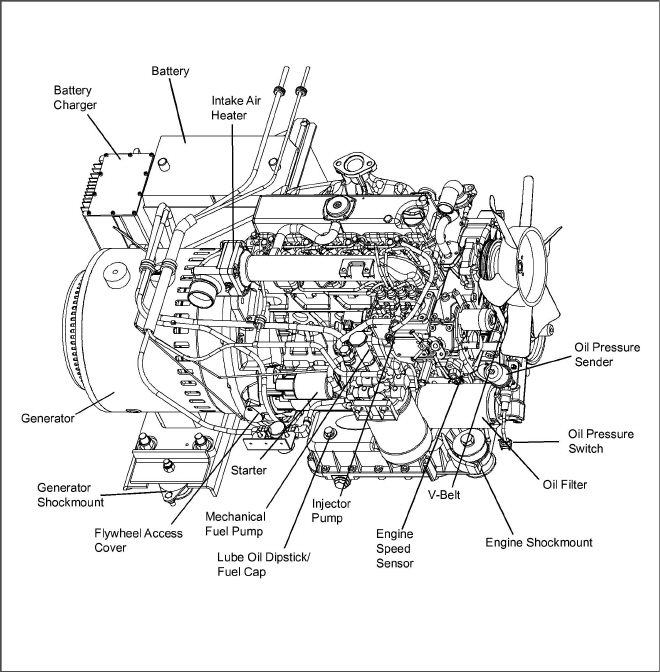
Section 2
The Carrier Transicold model 69UG15 under-mounted diesel-driven generator sets provide electrical power for all-electric refrigeration units.
The generator set (see Figure 2.2, Figure 2.4 and Figure 2.6) consists of a diesel engine direct-connected to an alternating current generator and mounted in a structural steel frame. The engine is a vertical in-line, four cylinder diesel manufactured by Kubota, while the generator is a 15 kW, brushless, dual bearing type. Generator sets will start at 50Hz. Once the unit is running, the voltage controller will read the voltage output of the generator and adjust accordingly, to keep the voltage within ISO limits. As the Container becomes loaded, voltage drops and current increases, the generator set will switch windings or speed based on power demand and ambient conditions. The unit will typically run at 50Hz and will vary generator output via winding selection. The speed change to 60 Hz will typically occur when the ambient temperature is high and the unit is heavily loaded.
Electrical controls are mounted in a control box with operating controls and gauges mounted on a control panel, which also serves as the control box cover. The control panel components are protected by a deflector assembly and a windowed control box door.
Auxiliary engine equipment consists of the battery, solid state battery charging system, “spin-on” lube oil filter, fuel filter and other necessary components for proper unit operation. The water pump and the radiator cooling fan are belt-driven from the engine crankshaft. All references to engine are as viewed from the fly wheel end.
The 69UG15 is available as a standard configuration, with an Auto Restart option or with Auto Restart and Low Coolant Sensor. The Auto Restart option automatically restarts the unit in the event of a unit shutdown. Auto Restart also offers built-in indicators that signal low oil pressure, high water temperature, overspeed, and other overcrank conditions.
Carrier Transicold’s Ecodriven dual speed option provides an energy saving alternative to the practice of continuously running the generator at full speed. This speed reduction results in increased fuel economy, reduced carbon footprint, and lowers operating costs.
2.2Configuration Identification
Generator set identification information is provided on a label located below the left mounting pad to the left of the access service door (front facing). The label provides the generator set model number, serial number, and parts identification number (PID). The model number identifies the overall configuration while the PID provides information on specific optional equipment and differences in detailed parts.
The model number, serial number and PID number must be included when ordering parts and inquiring about your unit.
Separately bound manuals covering the diesel engine are also available (see the following chart).
Manual Number |
Equipment Covered |
Type of Manual |
|---|---|---|
62-11335 |
V2203-DI |
Engine Part List |
62-11362 |
V2203-DI |
Workshop |
Figure 2.1 Unit View, UniDrive (PIDs prior to UG 2019)

Figure 2.2 Unit View, UniDrive (PIDs UG2019 and Up)
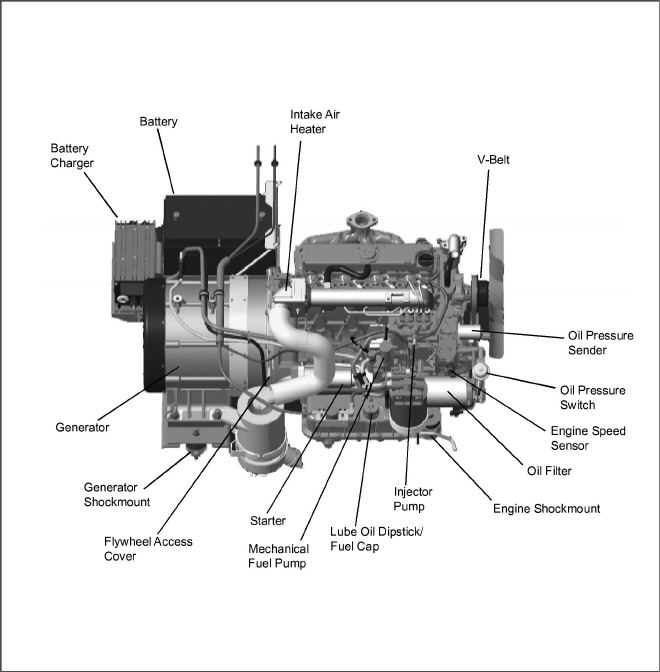
Figure 2.3 Unit View, Front (PIDs prior to UG2019)
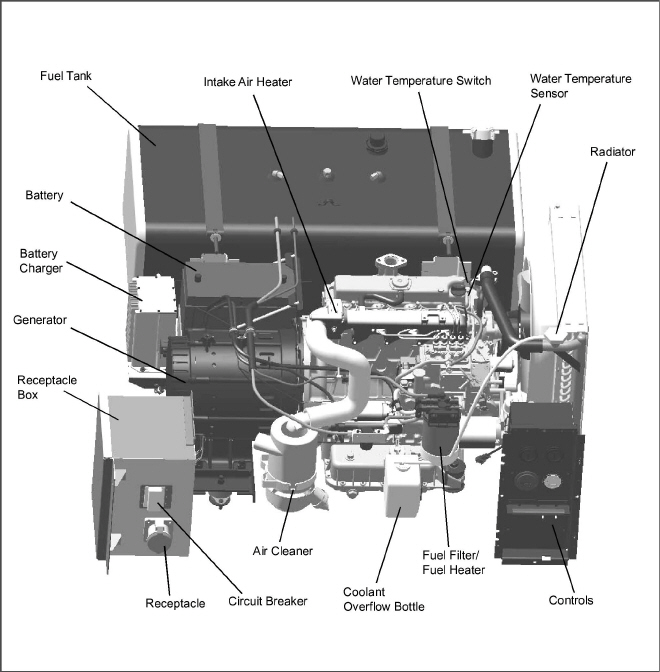
Figure 2.4 Unit View, Front (PIDs UG2019 and Up)
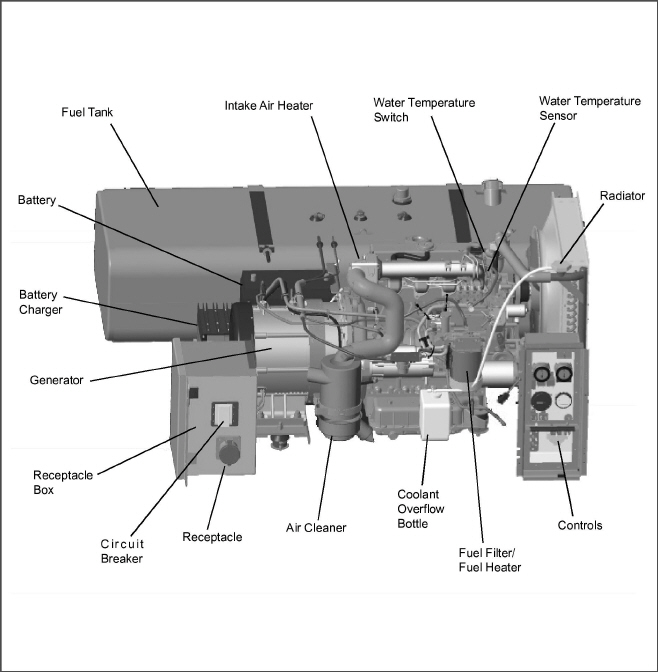
Figure 2.5 Unit View, Top (PIDs prior to UG2019)
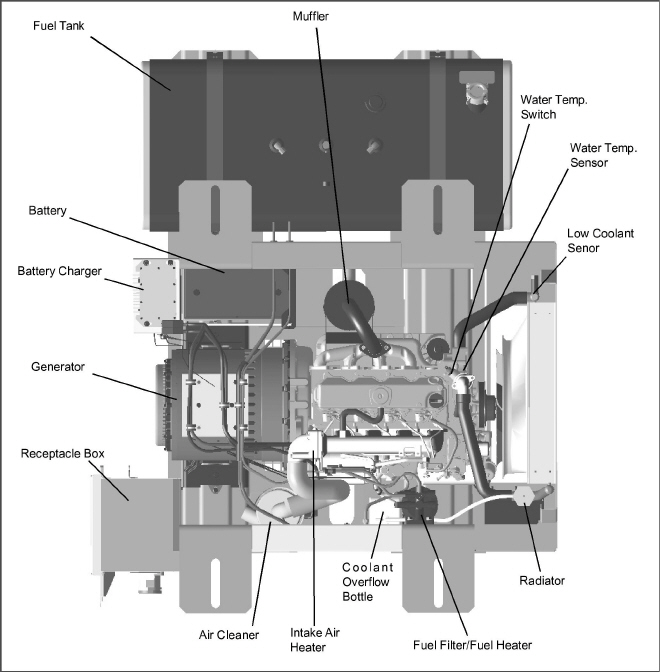
Figure 2.6 Unit View, Top (PIDs UG2019 and Up)
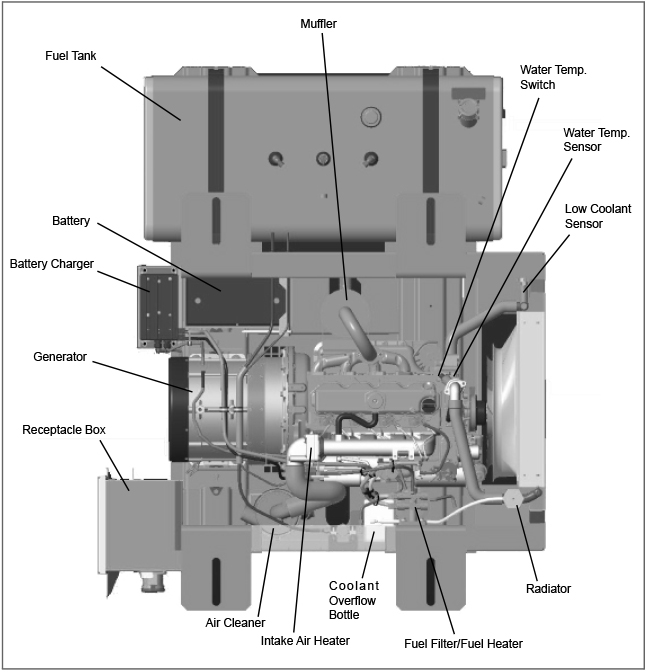
The engine is a vertical, in-line four cylinder diesel engine, which is directly connected to the alternating current generator. Information on the major engine systems is provided in the following sub-paragraphs.
2.3.1Electronic Governor Module
The electronic governor module (EG) is a solid state control module pre-programmed for 1800 RPM high speed and 1500 RPM low speed operation.
The EG unit has an LED which may be used to diagnose failures within the electronic speed control system, refer to Section 4.5 for additional troubleshooting information on diagnosing failures.
Figure 2.7 Electronic Governor Module
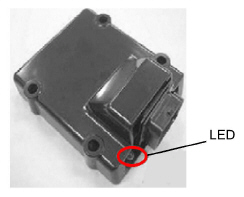
The air cleaner (see Figure 2.4) is designed to prolong engine life and performance by preventing dirt and grit from entering the engine and causing excessive wear on all operating parts. In order for the air filter to operate properly, the operator must regularly maintain the air cleaner equipment in accordance with the instructions provided within this document.
The fuel system is fitted with an in-line fuel strainer and a fuel filter, which also acts as a water separator. The fuel system is shown in Figure 2.8. The fuel heater system is located in the fuel filter and uses a 12 volt heater to heat fuel as it passes through the fuel filter, see Figure 2.8.
Figure 2.8 Fuel System Diagram
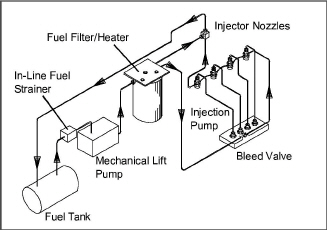
2.3.4Lube Oil Filter Arrangement
The engine lubricating oil filter is mounted in a horizontal arrangement and shown in Figure 2.9.
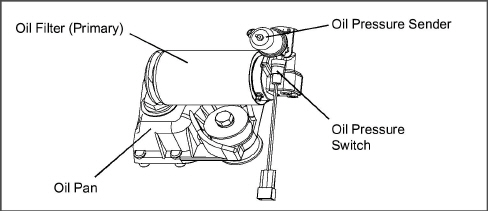
All threads used on the engine are metric except for the oil drain plug, which is American Standard Pipe Thread (NPT).
2.4Alternating Current Generator
The generator is directly bolted to the engine and supplies nominal 50/60Hz power depending on the load requirement.
The solid state battery charger (see Figure 2.2) is located in front of the battery. The battery charger is powered by the generator, and this input is protected by fuses located in the receptacle box. The battery charger produces a tapered charge (40 amps maximum) and is designed not to overcharge the battery.
Observe proper polarity when installing the battery or connecting a battery charger. The negative battery terminal must be grounded. Reverse polarity may damage the charging system. When charging the battery in unit, isolate the battery by disconnecting the negative battery terminal first, then the positive. Once the battery has been charged, connect the positive battery terminal first, then the negative.
Voltage Controller maintains ISO voltage via two-speed and dual winding control. It is used to regulate voltage in order to keep the generator output within ISO limits:
50Hz - 1500 RPM, 360 - 460 VAC
60Hz - 1800 RPM, 400 - 500 VAC
2.7Operating Controls & Instruments
Components required for monitoring and controlling the Genset unit are located in the control box, on the control panel and on the receptacle box.
2.7.2Control Panel and Related Components
1.Gauges and Senders
a.Oil Pressure Gauge (see Figure 2.10)
The purpose of this gauge is to observe normal operating engine oil pressure. Normal oil pressure is 35 to 60 psig (3.3 to 5.2 kg/cm2).
b. Oil Pressure Sender (see Figure 2.9)
This device senses engine lube oil pressure and transmits a signal to the oil pressure gauge. The oil pressure sender is located on the oil filter housing.
c.Water Temperature Gauge (see Figure 2.10)
The function of this gauge is to observe water operating temperature. The gauge is connected to the water temperature sensor.
d.Water Temperature Sensor (see Figure 2.6)
This device senses engine water temperature and transmits a signal to the water temperature gauge.
e.Low Coolant Sensor (see Figure 2.6)
This device senses the coolant level inside the radiator and will complete a conductive circuit as long as the probes remain immersed in coolant. When coolant level falls below the probes, a signal is sent to the auto restart module, shutting down the engine & all 12-volt circuitry.
f.Auto Restart Module (If So Equipped) see Figure 2.12)
Auto start/restart is provided to simplify the start-up process and provide an automatic restart feature that will automatically attempt to restart the unit in the event of shutdown. Four LEDs are used to indicate shutdown from overcrank, overspeed, low oil pressure, and high water temperature. A fifth LED is used to indicate the unit is running (see Figure 2.12). Refer to Table 2–2 for system preset values.
The auto restart function will perform a series of six attempts to restart the unit and make three attempts within each series. Once the function has completed all 18 attempts, the unit will automatically lock out future crank attempts. Refer to Table 2–2 for detailed information on auto restart sequencing.
2.Meters
a.Ammeter (A)
The ammeter (see Figure 2.10) is an indicator of the charging system and unit electrical draw. It indicates the rate of discharge or charge of the battery. During start up, the intake heater draws approximately 42 amps.
b.Total Time Meter (TT)
The total time meter (see Figure 2.10) calculates the total hours and provides an accurate readout of accumulated engine running time. This data can be used to establish proper maintenance schedules (refer to Section 4.1).
3.Manual Switches
a.Intake Heater Switch (HS) (see Figure 2.10)
The intake heater switch is a momentary switch. When held in the PREHEAT position, the switch allows approximately 42 amps of battery current to flow into the intake heater, which preheats the air within the intake manifold and allows the engine to start. After starting the engine, the intake heater switch should continue to be held in the ON position for approximately 5 seconds until the engine has developed enough oil pressure to close the oil pressure safety switch.
b.Ignition Switch (IGN) (see Figure 2.10)
The ignition switch is a momentary switch that has OFF/ON/START positions. When held in the START
(ignition) position, it energizes the starter motor solenoid, which in turn allows the starter motor to crank the engine. The switch is released to the RUN position once the engine has started.
c.Ignition Switch (IGN)(Auto Restart) (see Figure 2.10)
The ignition switch is a maintained contact switch that has the RUN/OFF positions. When switched to the RUN position, it energizes the control module, which in turn controls all functions of the Genset.
4.Timers
a.Intake Heater Timer (IHT) (If So Equipped)
The Intake Heater Timer continues to supply power to the intake heater for 3 minutes after initial start-up.
b.Starter Timer (SST)
The Starter Timer limits the amount of time that the starter can be engaged to 15 seconds. If the starter is manually engaged for more than 15 seconds, power will be cut to the starter. Once power has been removed, the starter can again be engaged for up to 15 seconds.
Figure 2.10 Control Panel and Box, Standard
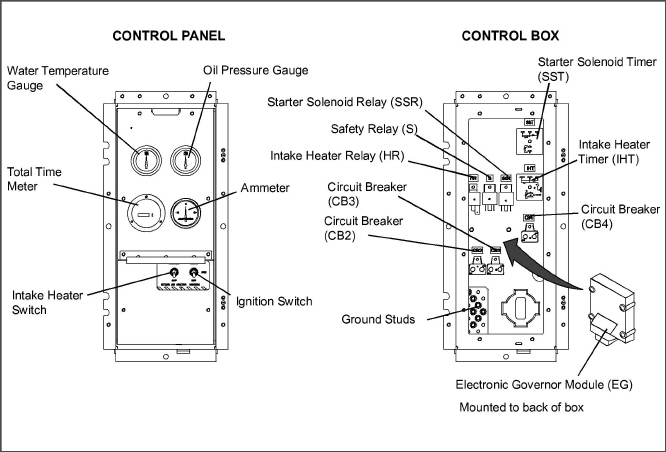
Figure 2.11 Control Panel and Box & Auto Restart
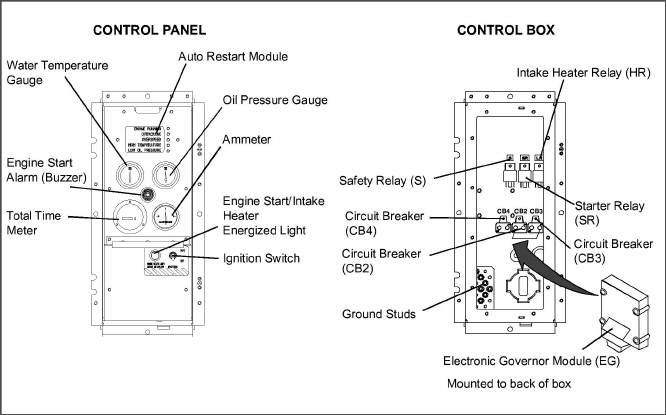
Figure 2.12 Control Panel and box, Auto Restart & Low Coolant Sensor
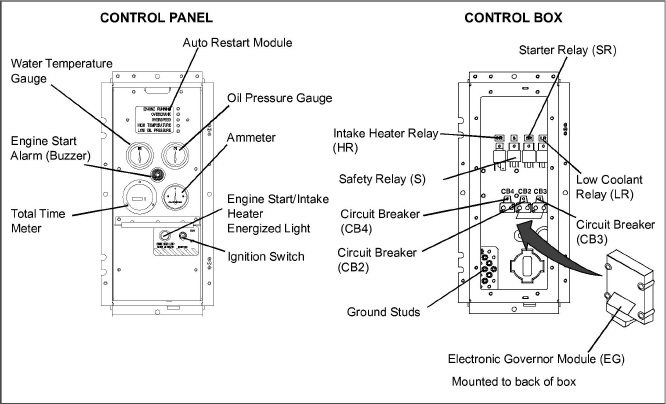
Indicator |
Preset Value |
Description |
|---|---|---|
Overspeed |
2100 RPM |
Overspeed is the point at which the unit will signal for shutdown |
Crank Disconnect |
700 RPM |
Crank Disconnect is the point at which the auto restart module senses the engine has started and will disengage the starter |
Shutdown Lockout Delay |
15 seconds |
The oil pressure and water temperature inputs are ignored during this 15 second delay (after start up) |
Intake Heater Delay |
30 seconds preheat 3 minutes postheat |
The delay is used during start up. The intake heater delay begins timing after the auto restart module signal is received. During the entire delay, the intake heater circuit will be energized, an indicator light will be illuminated, and an alarm will sound. When the delay expires, the unit will crank. |
Crank Attempts |
18 attempts |
A series of six attempts with three attempts in each series (total of 18 attempts) |
Figure 2.13 Receptacle Box
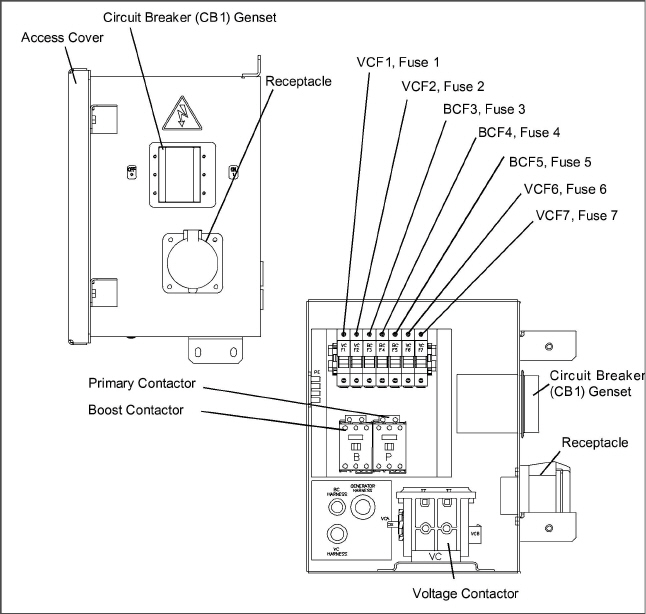
Table 2–2 Auto Restart Sequencing
*Engine crank and rest is repeated three times each series unless the engine starts. |
||
Series Attempt Number |
1 |
Engine Status: If the engine starts: 1.Run sequence begins 2.Intake heater remains energized for 3 minutes If the engine fails to start: 1.Intake heater will de-energize. 2.Fuel solenoid will de-energize. 3.Crank output will de-energize. 4.Overcrank LED will flash once. Wait two seconds and repeat. 5.Unit will rest 30 minutes and proceed to the next series. |
Intake Heater Energized (Seconds) |
30 |
|
Fuel Solenoid Engaged |
Yes |
|
Engine Crank Duration (Seconds) |
Up to 15 |
|
Engine Rest Duration (Seconds) |
25 |
|
Series Attempt Number |
2 |
Engine Status: If the engine starts: 1.Run sequence begins 2.Intake heater remains energized for 3 minutes If the engine fails to start: 1.Intake heater will de-energize. 2.Fuel solenoid will de-energize. 3.Crank output will de-energize. 4.Overcrank LED will flash twice. Wait two seconds and repeat. 5.Unit will rest 30 minutes and proceed to the next series. |
Intake Heater Energized (Seconds) |
30 |
|
Fuel Solenoid Engaged |
Yes |
|
Engine Crank Duration (Seconds) |
Up to 15 |
|
Engine Rest Duration (Seconds) |
25 |
|
|
|
|
Series Attempt Number |
3 |
Engine Status: If the engine starts: 1.Run sequence begins. If the engine fails to start: 1.Intake heater will de-energize. 2.Fuel solenoid will de-energize. 3.Crank output will de-energize. 4.Overcrank LED will flash three times. Wait two seconds and repeat. 5.Unit will rest five hours and proceed to the next series. |
Intake Heater Energized (Seconds) |
30 |
|
Fuel Solenoid Engaged |
Yes |
|
Engine Crank Duration (Seconds) |
Up to 15 |
|
Engine Rest Duration (Seconds) |
25 |
|
|
|
|
Series Attempt Number |
4 |
Engine Status: If the engine starts: 1.Run sequence begins. If the engine fails to start: 1.Intake heater will de-energize. 2.Fuel solenoid will de-energize. 3.Crank output will de-energize. 4.Overcrank LED will flash four times. Wait two seconds and repeat. 5.Unit will rest five hours and proceed to the next series. |
Intake Heater Energized in Seconds |
30 |
|
Fuel Solenoid Engaged |
Yes |
|
Engine Crank Duration (Seconds) |
Up to 15 |
|
Engine Rest Duration (Seconds) |
25 |
|
|
|
|
Series Attempt Number |
5 |
Engine Status: If the engine starts: 1.Run sequence begins. If the engine fails to start: 1.Intake heater will de-energize. 2.Fuel solenoid will de-energize. 3.Crank output will de-energize. 4.Overcrank LED will flash five times. Wait two seconds and repeat. 5.Unit will rest five hours and proceed to the next series. |
Intake Heater Energized (Seconds) |
30 |
|
Fuel Solenoid Engaged |
Yes |
|
Engine Crank Duration (Seconds) |
Up to 15 |
|
Engine Rest Duration (Seconds) |
25 |
|
|
|
|
Series Attempt Number |
6 |
Engine Status: If the engine starts: 1.Run sequence begins. If the engine fails to start: 1.Intake heater will de-energize. 2.Fuel solenoid will de-energize. 3.Crank output will de-energize. 4.Overcrank LED will illuminate solid and lock out future crank attempts. 5.To reset, turn unit power switch OFF and back ON.. |
Intake Heater Energized (Seconds) |
30 |
|
Fuel Solenoid Engaged |
Yes |
|
Engine Crank Duration (Seconds) |
Up to 15 |
|
Engine Rest Duration (Seconds) |
25 |
|
Safety devices, such as circuit breakers, fuses, and safety switches protect system components from damage.
The AC generator, solid state battery charger, fuel heater, high water temperature, safety relay, total time meter and intake heater are protected by circuit breakers. If a safety device opens and there is an interruption of electrical current, the electronic governor module will be de-energized, which will also de-energize the fuel solenoid, interrupt the fuel flow to the engine and stop the engine.
In units with auto restart, the engine, engine control devices, and engine monitoring devices are protected by the auto restart module, low coolant sensor (if equipped), circuit breaker, low oil pressure switch, and high water temperature switch. These safety devices monitor system operating conditions and open a set of electrical contacts when an unsafe condition occurs. If a safety device opens and there is an interruption of electrical current, the electronic governor module will be de-energized, which will also de-energize the fuel solenoid, interrupt the fuel flow to the engine and stop the engine.
De-energizing the fuel solenoid shuts off the fuel supply to the engine; thus stopping the engine. Safety device specifications are provided in Table 2–3.
Fuel Tanks: |
||
|
Nominal Tank Sizes |
50 Gallon Steel |
Fill Capacity |
52 Gallons (197 liters) |
|
Draw Capacity |
50 Gallons (189 liters) |
|
|
|
|
|
Nominal Tank Sizes |
50 Gallon Aluminum |
Fill Capacity |
52 Gallons (197 liters) |
|
Draw Capacity |
50 Gallons (189 liters) |
|
|
|
|
|
Nominal Tank Sizes |
65 Gallon Steel |
Fill Capacity |
67.5 Gallons (256 liters) |
|
Draw Capacity |
65 Gallons (246 liters) |
|
|
|
|
|
Nominal Tank Sizes |
80 Gallon Aluminum |
Fill Capacity |
85 Gallons (322 liters) |
|
Draw Capacity |
80 Gallons (303 liters) |
|
Weights: |
||
|
Battery |
63 lb (28.6 kg) |
Generator (A-C) |
197 lb (89 kg) |
|
Engine (Dry) - without Accessories |
439 lb (199 kg) approximate |
|
Unit (with 50 gallon steel tank, dry) |
- |
|
Unit (with 50 gallon aluminum tank, dry) |
- |
|
Unit (with 65 gallon steel tank, dry) |
1555lb (705 kg) |
|
Unit (with 80 gallon aluminum tank, dry) |
|
|
Bore /Stroke: |
3.26 in. (83 mm) / 4.03 in. (102.4 mm) |
|
Compression Ratio: |
22.0 : 1 |
|
Cylinders (Number): |
Four |
|
Displacement: |
135.2 cubic inches (2.22 liters) (2216 cm3) |
|
Firing Order: |
1-3-4-2 |
|
Lubrication System: |
Oil Pressure Safety Switch Setting Opens |
18 psig (1.27 kg/cm2) |
Capacity |
Engine - 15.0 US quarts (14.2 liters), includes standard filter. |
|
Oil Level Indicator |
Dipstick in oil pan or fill cap NOTE: |
|
Lube Oil Specification |
Use a heavy duty lubricating oil conforming to American Petroleum Institute (API) Service Classification CF or better. |
|
Lube Oil Viscosity |
Outdoor Temperature |
|
Fahrenheit: 0°F to 45°F Centigrade: -18°C to 7°C SAE: 10W30 or Mobile Delvac 1* |
||
Fahrenheit: 45°F and above Centigrade: 7°C and above SAE: 10W30 or 15W40 or Mobile Delvac 1* |
||
* Mobile Delvac 1, 5W-40 or 15W-40 is the only approved synthetic oil. |
||
Fuel and Fuel Heater Thermostat (FHT): |
||
Fuel |
Winter |
Diesel No. 2 with winter blends |
Summer |
Diesel No. 2 |
|
FHT |
Winter |
Close on temperature fall @ 45+/- 6.5°F |
Summer |
Open on temperature rise @ 75+/- 6.5°F |
|
Power Consumption: 150 Watts @ +/- 10% at 14 VDC |
||
-Diesel Fuel Specification Type and Sulfur Content % (ppm) used, must be compliant with all applicable emission regulations for the area in which the engine is operated. - Since KUBOTA diesel engines of less than 56 kW (75 hp) utilize EPA Tier 4 and Interim Tier 4 standards, the use of ultra low sulfur fuel is mandatory for these engines, when operated in US EPA regulated areas. Therefore, please use No.2-D S15 diesel fuel. Ultra Low Sulfur Diesel (ULSD) 15 ppm or 0.0015 wt.% |
||
Intake Heater: |
Amperage - 42 amps at 12 VDC |
|
Resistance (cold) - Approx. 0.3 ohms |
||
Horsepower: |
24.8 HP @ 1800 RPM at sea level. (SAE J1995 Gross Power Rating) |
|
Cooling System: |
Capacity |
6 U.S. quarts (5.68 liters) - includes 1 quart (0.95 liter) in coolant recovery bottle. (Refer to section 4.4.5) |
Anti-Freeze: Extended Life |
The cooling system is factory charged with a 50/50 mix of extended life coolant (ELC) and deionized water. This mixture provides protection to -34°F (-37°C). For replacement, with extended life coolant (ELC) meeting ASTM D4656 specification and deionized water. A 50/50 mix is recommended. Extended life coolant is red or orange in color. DO NOT mix with conventional coolant. |
|
Water Temperature Safety Switch Setting: |
||
Opens |
230 +/- 5°F (110 +/- 3°C) |
|
Resets |
200°F (93°C) - minimum |
|
Thermostat: |
||
Starts to open |
177 to 182°F (80 to 84°C) |
|
Fully open |
203°F (95°C) |
|
Low Coolant Sensor: |
||
Opens |
Los of 32 ounces of coolant or more |
|
Closes |
Refilling of radiator to proper level |
|
Lubrication System: |
Oil Pressure |
35 to 60 psig (3.3 to 5.2 kg/cm) |
Electrical: |
Generator |
400-500 VAC @ 60 hz 360-460 VAC @ 50 hz |